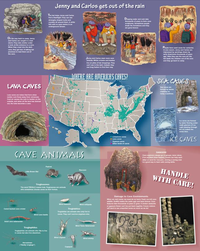"Exploring Caves" is an interdisciplinary set of materials on caves for grades K-3. Caves entail at least five scientific disciplines: earth science, hydrology, mapping, biology, and anthropology. Each of these disciplines involves a unique content area as well as the development of particular intellectual skills. This unit aims at helping teachers to sort and organize the most important ideas in this rich scientific area. Detailed lesson plans serve as ways to pass these ideas on to very young students. Most American caves are big holes that form in limestone rock. The holes begin as cracks in limestone. The cracks get bigger and bigger. They grow into underground streams, rivers, and even lakes. When water drains away, the waterways turn into open cave tunnels, passages, and caverns. It takes 10,000 to 100,000 years to form a cave big enough for people to move around inside. Water drips constantly in caves. The drips dissolve limestone minerals in one part of the cave. As water dries out, the minerals build up in other places. In this way, beautiful cave rock formations and crystals grow over thousands of years. These rock formations change dark limestone caves into hidden fantasy lands.


